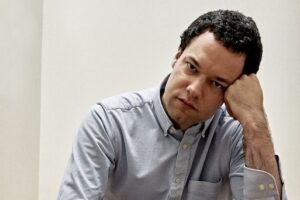4TH Quarter 2021
Miraculous Momentum — Portrait of a Time Traveler
By Tricia Stewart Shiu
Miraculous Momentum – Read by Tricia Stewart Shiu

Time is money. Time is relative. Time heals all wounds. Time to lean, time to clean.
Time is so many things, to so many people.
Much of our existence either revolves around or is spent escaping the inevitable passage of time.
But, that measurement on which so many of us construct our lives, emotionally connect and base our belief systems, is fairly arbitrary.
ARTISTIC ALLEGORY | LE MOT JUSTE
The Mathematical Association of America says, “The measurement of time began with the invention of sundials in Ancient Egypt sometime prior to 1500 B.C. However, the time the Egyptians measured was not the same as the time today’s clocks measure. For the Egyptians, and indeed for a further three millennia, the basic unit of time was the period of daylight.”
 However, Industrialization and the invention of the lightbulb were just two events that shaped, or maybe warped, our sense of time.
However, Industrialization and the invention of the lightbulb were just two events that shaped, or maybe warped, our sense of time.
So, here we are. Biding, racing, scanning, making, marking, healing…
Suppose, that while we are doing all those things, a moment of measurement could stretch out or take a detour. For one almost imperceptible, blink-of-an-eye moment, imagine that time does something unexpected and we are able to hop to another timeline or visit our past self, skip ahead—minutes, hours or millennia—or even stand outside ourselves and look at the present with a new perspective.
What if these very words that you are reading, right now, were created 1,000 years from now and are being channeled from the future self of this writer?
The title, words chosen, intention behind the article—what if the research was gathered in the past, filtered by the present, then, finally written through a future connection.
Of course, that is just this writer’s story. Yours could involve any number of people, locations, or scenarios. How about you travel into the future? It is more science and less fiction than you might think. The trouble isn’t fast-forwarding in time, it’s the return travel that’s an issue, but, more on that later.
 A video on the Science Channel, How to Time Travel (Kind Of) | How the Universe Works, offers some expert advice about exactly how one might go about traveling into the future.
A video on the Science Channel, How to Time Travel (Kind Of) | How the Universe Works, offers some expert advice about exactly how one might go about traveling into the future.
To begin, we must start by reframing our understanding and definition of time.
“So, instead of thinking of our universe as a 3 dimensional place that just changes over time,” explains Physicist, Max Tegmark. “We should think of reality as a 4 dimensional place known as space-time.”
More specifically, we can think of the space-time continuum where motion through space is linked to motion through time. To break it down: “Because space consists of 3 dimensions, and time is 1-dimensional, space-time must, therefore, be a 4-dimensional object. It is believed to be a ‘continuum’ because so far as we know, there are no missing points in space or instants in time, and both can be subdivided without any apparent limit in size or duration,” says an article “Special & General Relativity Questions and Answers,” So, physicists now routinely consider our world to be embedded in this 4-dimensional Space-Time continuum, and all events, places, moments in history, actions and so on are described in terms of their location in Space-Time.”
The scientists interviewed for the Science Channel segment agreed that you’d have to rocket into space and orbit the earth at almost the speed of light. It’s hard to imagine how fast that might be.
“To put it in perspective, just how fast that is,” says Astrophysicist, Hakeem Oluseyi, “The fastest human-piloted vehicle in history was Apollo 10, and it went 25,000 mph. You would need to go more than 25,000 times faster than that. That’s pretty fast.”
 Although physics might make time travel possible at some point, there are no vehicles equipped to handle the energy required for the speed necessary to travel at the speed of light. Not only that but once you get there, there is no way to go back in time. So, you’d be stuck in the future.
Although physics might make time travel possible at some point, there are no vehicles equipped to handle the energy required for the speed necessary to travel at the speed of light. Not only that but once you get there, there is no way to go back in time. So, you’d be stuck in the future.
There is nothing to stop anyone from imaging the possibilities. In fact, Albert Einstein, the father of modern physics, said, “To raise new questions, new possibilities, to regard old problems from a new angle, requires creative imagination and marks real advance in science.”
Perhaps our imagining could be the next step to conquering a new space-time frontier. Who knows, this article could play a pivotal role in someone’s theoretical physics epiphany. Cheers to our future selves!





